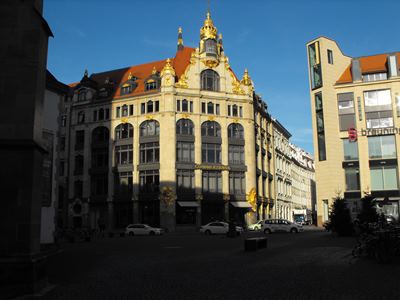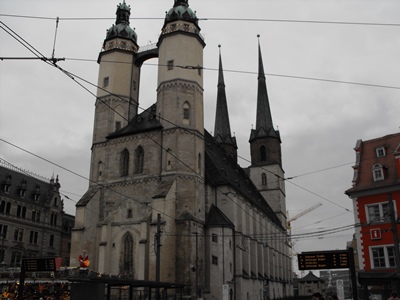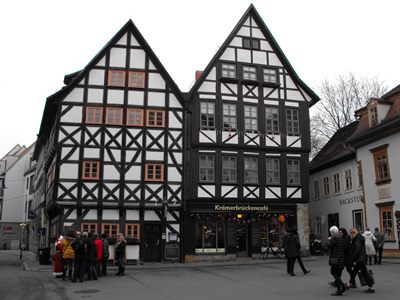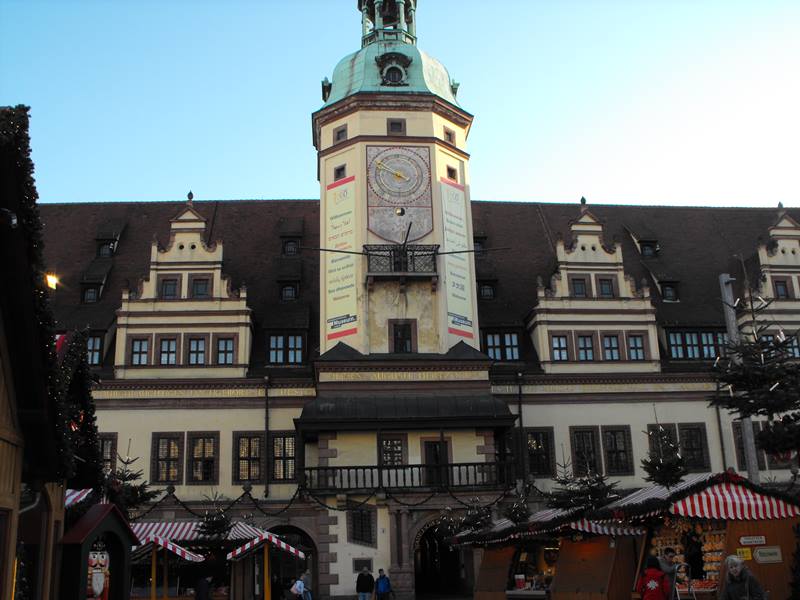SITE LINKS
| LISBON |
| MAINZ |
| OPORTO |
| VALLADOLID |
| DRESDEN |
| HAMBURG |
| MUNICH |
| LEIPZIG |
 |

Top: LEIPZIG Altes Rathaus
Above: LEIPZIG Commerz Bank
Below: HALLE Unser Lieben Frauen Kirche
Bottom: ERFURT near Kramerbrucke



Above:
The Altes Rathaus in Leipzig.
Leipzig is located in Saxony. Following serious bombing damage in WW2, the city lay in the eastern sector of the country until reunification in 1989, a development which had its impetus from peaceful protests in Leipzig. The city was rebuillt after 1945 and includes both some excellent recreations of historical structures and examples of Communist architecture.
Its Tourist Office provides plentiful information and its offices may be found at Augustusplatz 9 and Katharinenstrasse 8.
The main station (Hauptbahnhof) is arguably the largest in Western Europe and has been enhanced by the addition of well over 100 shops on the lower levels. Services to the station are provided by the national DB railways ,and the suburban S-Bahn network and the more local extensive tram system provided by LVB. Ticket machines for both DB and LVB are widely available. The DB machines have an English language option which makes them easy to use. You can also use the DB Reisezentrum but tickets are slightly more expensive from there.
The city has some excellent beerhouses including the iconic Auerbachs Keller in the historic Madler Pasage. Also well worth a visit is the branch of the Czech brewhouse Wenzel Prager Bierstuben in Kleine Fleischergasse 8 and the nearby Zigarre restaurant, at Barfussgaesschen 10 which, despite its Italian name, offers good German fare, too.
City landmarks include the magnificent Alte Rathaus which also houses the city's museum. The new town hall is also worth a look. There are also magnificent churches, notably those of St Nikolai and St Thomas.
A well sited hotel is the Marriott Leipzig, which is just a few hundred yards from the main railway station.
The Leipzig Christmas market is one of the biggest in Germany and is held from late November each year, with stalls around the Altes Rathaus area as well as Augustusplatz and the streets between these locations such as Grimmaischestrasse. Commemorative mugs and glasses are produced each year and these can be kept by customers if they forego the deposit (Pfand) which is charged on each drink when ordered. (Typically the Pfand was two Euros in 2016).
The city is also well provided for in terms of shops and its numerous historic arcades must not be missed.
Getting to Leipzig from the UK is often involves a change of plane, e.g. at Dusseldorf. Eurowings/Germanwings serve Leipzig-Halle airport, which is located west of the city and is connected by a twice-hourly S-Bahn service as well as by other DB services. It is a long but enclosed walk from the air terminal to the railway station and it is not brilliantly signposted at the railway end. There are excaltors/lifts down to the platforms - make sure you are on the right one! There is (2015) just one ticket machine on each platform which is not very useful when there is a queue of foreign toursits who do not know how to use it!
Nearby places to visit include:
- Halle -
easily reached on the S-Bahn line S5/S5X. Catch the
tram (nos. 2,5,7,9) to the left of the station
forecourt to the historic Markt area which has the
superb Red Tower and User Lieben Frauen church.
The town has musical connections; Handel lived here -
but there is also a Beatles Museum! For eating and
drinking, as well as numerous German establishments,
there is a branch of the excellent Czech
brewhouse Wenzel Prager Bierstuben in Grosse
Nikolaistrasse near the Handel-Haus.
- Erfurt - This city in Thuringia is
reached by changing trains from Leipzig at
Weissenfels. Erfurt's impressive Rathaus at the
Fischmarkt and medieval Kramerbrucke bridge are
local landmarks. The latter is totally built upon and
can only be seen as a bridge by going behind the
buildings built upon it. It claims to be the longest
inhabited bridge in Europe. Also not to be missed is
the Domplatz which is an extensive area that can be
viewed from above by climbing the steps up to the Dom
(cathedral) itself.
- Dresden - Well
served by trains from Leipzig, this city will have its
own page on this site in due course. Despite its
destruction by bombing in World War II it has
re-established itself as a vibrant centre of culture.
- Weimar - This
is an attractive town with numerous historical and
musical associations, as well as an imposing Opera
House.
- Naumburg - If
you exit the main station entrance to the left, you
can catch the vintage tram (service no.4) which runs
every half hour, all year, on a 2.5km route around the
edge of town. Get off at Marientor or at Theaterplatz
for a short stroll to the main square. Alternatively,
you can catch a bus from the station or walk (1.5km)
to the town centre, via the massive Dom (cathedral).
- Jena: Although
badly damaged in the War it has an attractive main
square
The DB website has full timetable and fare information.